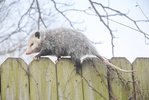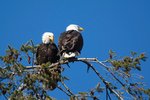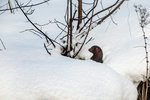 Narrowsburg
NarrowsburgLight Rain Fog/Mist, 43°
Wind: 8.1 mph
Even though Valentine’s Day has passed and spring has yet to commence, the call of the wild has been heard here in the mountains, and many creatures have already begun the mating dance. It …
Stay informed about your community and support local independent journalism.
Subscribe to The River Reporter today. click here
This item is available in full to subscribers.
Please log in to continueNeed an account?
|





 (2).jpeg)
In my humble opinion
Even though Valentine’s Day has passed and spring has yet to commence, the call of the wild has been heard here in the mountains, and many creatures have already begun the mating dance. It takes longer for some species than others, and while we have yet to see a robin building its nest, trust me—romance is in the air.
The variety of species referred to here are particular to where we live, but I’m fairly sure that both New York and Pennsylvania share them all and we’re called the River Reporter, because well… we cover both sides of the Delaware. That’s what the bridges are for. I don’t think the critters use them much, but you might have noticed a little more roadkill than usual, because a lot of these guys are on the move, and trust me, they are lookin’ for love.
First up—the aromatic skunk. According to Al LaFrance of Al’s Critter Solution, in a 2010 interview, “The weeks before, during and after Valentine’s Day is not a favorite time for New York nuisance animal removal specialists. It’s the skunk mating season and it’s a smelly time of year. The females are coming into estrus,” he explains, “and every male skunk within four city blocks wants to stop by and offer his services. If the female is not receptive to the male’s advances, she will spray,” Al states. Mmmm.
“That’s when everyone starts calling us up. They hear them squealing or screeching under their decks or crawl spaces. We get the calls that there’s a skunk in their basement because of the odor.”
I know I’m weird, but I have always liked the smell of skunk. It reminds me of home, wherever I may roam.
Here in the Upper Delaware River region, we are fortunate to have seen the return of the once-endangered bald eagle, and they also begin mating now, during the winter months. “Egg laying takes place as early as the end of February,” said Chris Lajewski, director of the Montezuma Audubon Center in Savannah, NY, and he adds that bald eagles become sexually mature at four to five years of age. “Ordinarily, the birds mate for life,” Lajewski explains, “but they will seek new mates if one dies or if the pair repeatedly fails at breeding.”
Viewing bald eagles that congregate in the Upper Delaware wintering areas has become a popular wildlife-watching activity. Well marked viewing sites are located on the river in Narrowsburg and Minisink Ford, NY, and in Lackawaxen, PA. A viewing blind is located on the Mongaup Falls Reservoir and another viewing area is marked on the Rio Reservoir in Forestburgh, NY.
There is some controversy online about whether coyotes will endanger your pets, but it’s definitely mating season and it makes sense to keep an eye on the animals that actually live in your house. Don’t let them roam without you.
“Coyotes are generally monogamous and maintain pair bonds that can last for several years,” according to coyote.smarts.org. “The breeding season runs from late December through March, and pups are born in early spring. Litter size depends on a variety of factors but typically ranges from four to six pups. Both parents care for their young, frequently with the help of older offspring. Coyotes make their dens in rocky crevices, dense thickets and sometimes the dens of other animals.” So be on the lookout. Lest we forget, they were all here first.
Wanna know one of my favorites? The fierce-looking but ever-so-shy (and harmless) opossum, North America’s only marsupial. “The breeding season is from late January through late March, and mid-May to early July. Most females produce two litters, sometimes a third,” according to the SUNY College of Environmental Science and Forestry’s Adirondack Ecological Center website.
“The gestation period is only 12 to 13 days, and the young are born at an early stage of development. At birth, each newborn opossum is about the size of a honeybee, (0.6 inches) in length, weighs 0.16 grams (0.0056 ounces), and is pink-to-translucent in color.” (Awww.) “The front feet possess clawed toes; the hind feet are small stubs. While giving birth, the female adopts a sitting posture and licks the fur of the abdomen and pouch.” Note: One opossum can eat about five thousand ticks each year, so we like having them around. Yeah, those teeth are scary—but trust me… they’re really adorable. IMHO.
There’s more: foxes are goin’ at it, as well as minks, beavers, ravens and, unlike many of their hooting counterparts, the great horned owl. “Many species of owls migrate south for the winter to escape the harsh weather and lack of prey. Not the great horned owl. It mates and nests in the winter months. Nesting early naturally entails some risk,” according to blog.nature.org. Eggs must be kept warm and incubated, which can be a challenge when the temperature is in the double digits and snow is falling.
“Owls are large birds. It takes them longer to grow and mature than, say a songbird. Early hatching means they’re ready to practice their flying and hunting skills when the weather is mild and prey is abundant.”
Here at Camp Fox, Dharma the Wonder Dog and I have the great pleasure of observing so much of this unfold. We hear the owls, we see the ‘possums, we talk to the ravens and sometimes I attempt to photograph them with a big zoom lens from a safe and respectful distance. It’s nice to know that some species mate for life and disturbing to learn that others are either “promiscuous” (river otters) or “violent” (think mink) which often begs the question—What’s love got to do with it?
For more info on all creatures great and small here in the Upper Delaware River region, visit https://www.newyorkupstate.com.
Fun Fact: “What’s Love Got to Do with It” is a song written by Terry Britten and Graham Lyle and recorded by the American singer Tina Turner; it was released in 1984.
Related stories

Comments
No comments on this item Please log in to comment by clicking here